Amana A8WXNGMWD, A8WXNGMWH Owner's Manual
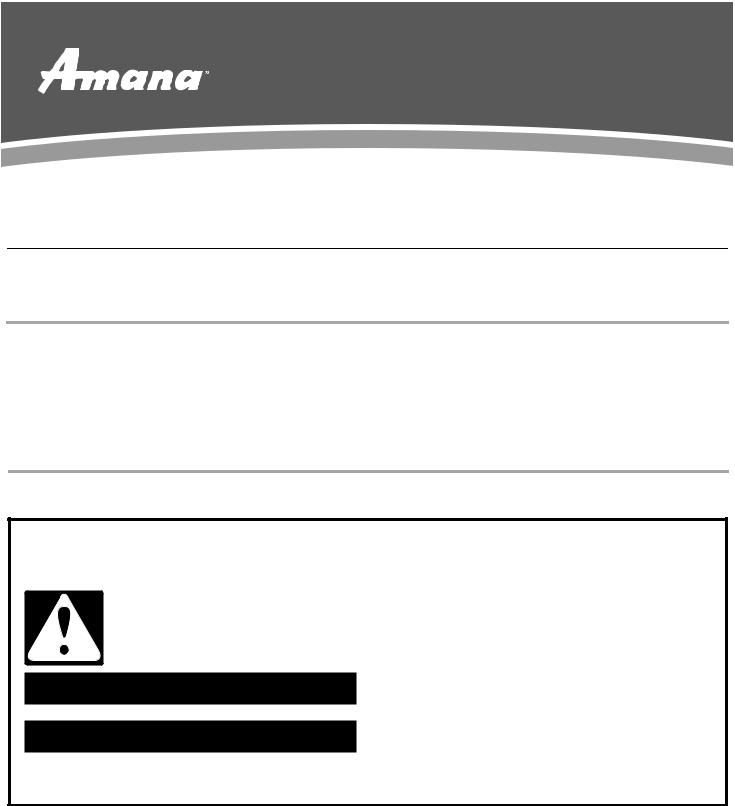
REFRIGERATOR USER INSTRUCTIONS
THANK YOU for purchasing this high-quality product. If you should experience a problem not covered in TROUBLESHOOTING, please visit our website at www.amana.com for additional information. If you still need assistance, call us at 1-800-843-0304. In Canada, visit our website at www.amanacanada.ca or call us at 1-800-807-6777.
You will need your model and serial number, located on the inside wall of the refrigerator compartment.
Para obtener acceso a “Instrucciones para el usuario del refrigerador” en español, o para obtener información adicional acerca de su producto, visite: www.amana.com.
Necesitará su número de modelo y de serie, ubicado en el interior del compartimiento del refrigerador.
TableofContents/Tabledesmatières
REFRIGERATOR SAFETY..................................................................... |
1 |
INSTALLATION INSTRUCTIONS ......................................................... |
2 |
REFRIGERATOR USE ........................................................................... |
9 |
REFRIGERATOR CARE....................................................................... |
12 |
TROUBLESHOOTING.......................................................................... |
13 |
WARRANTY.......................................................................................... |
15 |
SÉCURITÉ DU RÉFRIGÉRATEUR ..................................................... |
16 |
INSTRUCTIONS D’INSTALLATION ................................................... |
17 |
UTILISATION DU RÉFRIGÉRATEUR................................................. |
24 |
ENTRETIEN DU RÉFRIGÉRATEUR ................................................... |
27 |
DÉPANNAGE........................................................................................ |
29 |
GARANTIE............................................................................................ |
31 |
REFRIGERATORSAFETY
Your safety and the safety of others are very important.
We have provided many important safety messages in this manual and on your appliance. Always read and obey all safety messages.
This is the safety alert symbol.
This symbol alerts you to potential hazards that can kill or hurt you and others.
All safety messages will follow the safety alert symbol and either the word “DANGER” or “WARNING.” These words mean:
 DANGER
DANGER
 WARNING
WARNING
You can be killed or seriously injured if you don't immediately follow instructions.
You can be killed or seriously injured if you don't follow instructions.
All safety messages will tell you what the potential hazard is, tell you how to reduce the chance of injury, and tell you what can happen if the instructions are not followed.
W10211588A
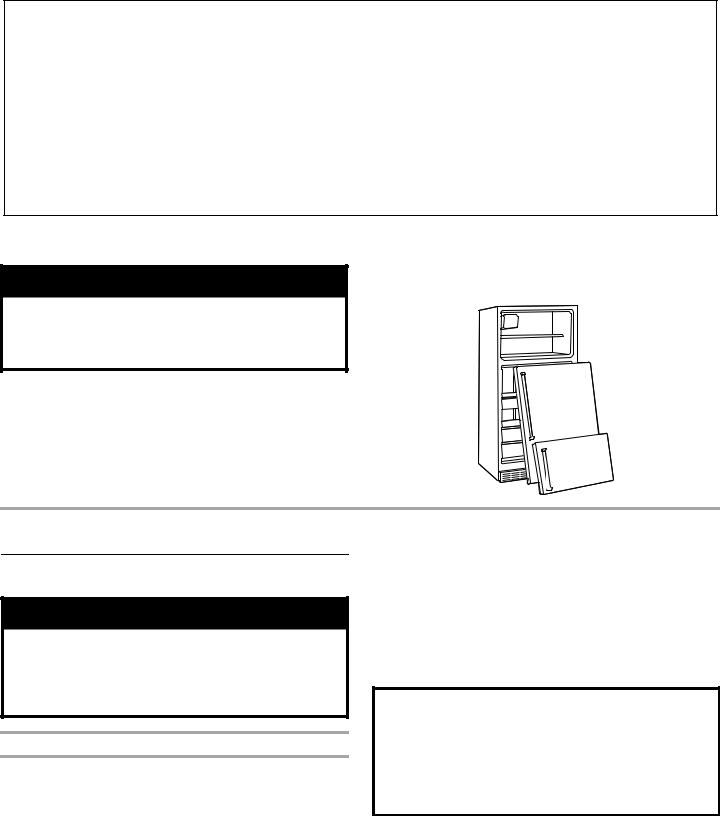
IMPORTANT SAFETY INSTRUCTIONS
WARNING:To reduce the risk of fire, electric shock, or injury to persons when using the refrigerator, follow basic precautions, including the following:
■Plug into a grounded 3 prong outlet.
■Do not remove ground prong.
■Do not use an adapter.
■Do not use an extension cord.
■Disconnect power before servicing.
■Replace all parts and panels before operating.
■Remove doors from your old refrigerator.
■Use nonflammable cleaner.
■Keep flammable materials and vapors, such as gasoline, away from refrigerator.
■Use two or more people to move and install refrigerator.
■Disconnect power before installing ice maker (on ice maker kit ready models only).
SAVE THESE INSTRUCTIONS
Proper Disposal of YourOld Refrigerator
Before You Throw Away Your Old Refrigerator or Freezer:
■Take off the doors.
 WARNING
WARNING
Suffocation Hazard
Remove doors from your old refrigerator.
Failure to do so can result in death or brain damage.
IMPORTANT: Child entrapment and suffocation are not problems of the past. Junked or abandoned refrigerators are still dangerous
– even if they will sit for “just a few days.” If you are getting rid of your old refrigerator, please follow these instructions to help prevent accidents.
■Leave the shelves in place so that children may not easily climb inside.
INSTALLATION INSTRUCTIONS
UnpacktheRefrigerator
 WARNING
WARNING
Excessive Weight Hazard
Use two or more people to move and install refrigerator.
Failure to do so can result in back or other injury.
Remove the Packaging
■Remove tape and glue residue from surfaces before turning on the refrigerator. Rub a small amount of liquid dish soap over the adhesive with your fingers. Wipe with warm water and dry.
■Do not use sharp instruments, rubbing alcohol, flammable fluids, or abrasive cleaners to remove tape or glue. These products can damage the surface of your refrigerator. For more information, see “Refrigerator Safety.”
■On some models, shelves, bins, door shelf rails, and other feature parts may be packaged in the Interior FeaturePak. Follow the instructions contained in the package for proper assembly.
■There are four bolts that secure the refrigerator to the shipping case. Keep these bolts because they are the refrigerator's leveling legs.
■Dispose of/recycle all packaging materials.
IMPORTANT: Do not remove the white foam air return insert that is located behind the control panel on the ceiling of the refrigerator (on some models). The insert is part of the refrigerator and not part of the packing material. If the insert is removed, ice may migrate down from the freezer and cause icicles to form.
When Moving Your Refrigerator:
Your refrigerator is heavy. When moving the refrigerator for cleaning or service, be sure to cover the floor with cardboard or hardboard to avoid floor damage. Always pull the refrigerator straight out when moving it. Do not wiggle or “walk” the refrigerator when trying to move it, as floor damage could occur.
2
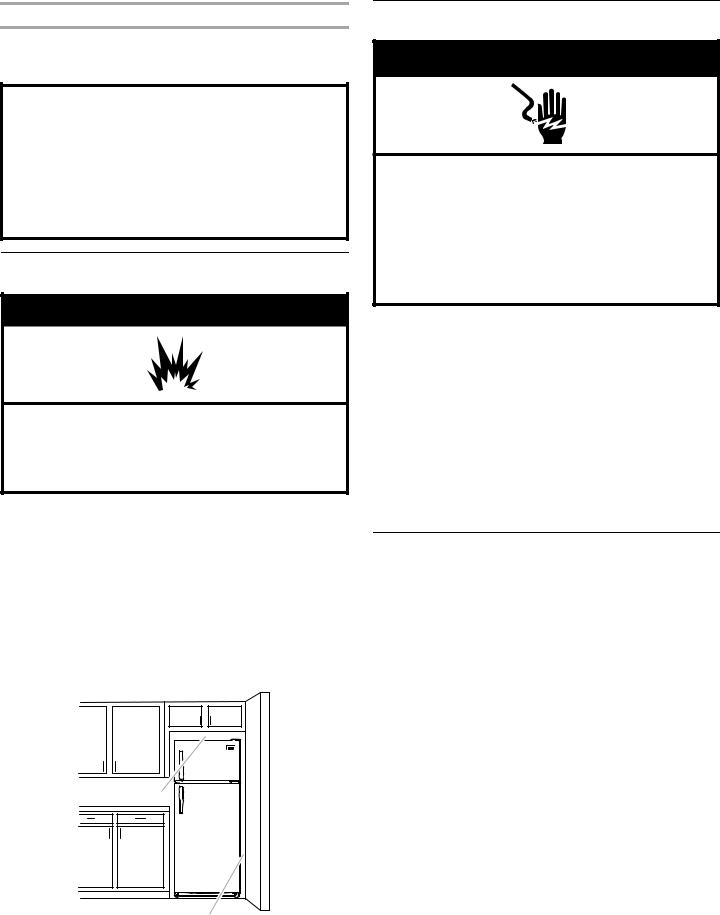
Clean Before Using
After you remove all of the package materials, clean the inside of your refrigerator before using it. See the cleaning instructions in “Refrigerator Care.”
Important information to know about glass shelves and covers:
Do not clean glass shelves or covers with warm water when they are cold. Shelves and covers may break if exposed to sudden temperature changes or impact, such as bumping. Tempered glass is designed to shatter into many small, pebble-size pieces. This is normal. Glass shelves and covers are heavy. Use both hands when removing them to avoid dropping.
LocationRequirements
 WARNING
WARNING
Explosion Hazard
Keep flammable materials and vapors, such as gasoline, away from refrigerator.
Failure to do so can result in death, explosion, or fire.
To ensure proper ventilation for your refrigerator, allow for a ¹⁄ " (12.70 mm) space on each side. Allow 3" (7.5 cm) of space between overhead cabinets and refrigerator top. Allow at least 1" (25.40 mm) between back of cabinet and the wall. If your refrigerator has an ice maker, make sure you leave some extra space at the back for the water line connections.
■If you are installing your refrigerator next to a fixed wall, leave 2" (5.08 cm) minimum on the hinge side (depending on your model) to allow for the door to swing open.
■Level the refrigerator. See “Adjust the Doors.”
NOTE: It is recommended that you do not install the refrigerator near an oven, radiator, or other heat source. Do not install in a location where the temperature will fall below 55°F (13°C).
3" (7.5 cm) |
2" (5.08 cm) |
ElectricalRequirements
 WARNING
WARNING
Electrical Shock Hazard
Plug into a grounded 3 prong outlet.
Do not remove ground prong.
Do not use an adapter.
Do not use an extension cord.
Failure to follow these instructions can result in death, fire, or electrical shock.
Before you move your refrigerator into its final location, it is important to make sure you have the proper electrical connection.
Recommended Grounding Method
A 115 Volt, 60 Hz., AC only 15or 20-amp fused, grounded electrical supply is required. It is recommended that a separate circuit serving only your refrigerator be provided. Use an outlet that cannot be turned off by a switch. Do not use an extension cord.
NOTE: Before performing any type of installation, cleaning, or removing a light bulb, turn the control (Thermostat, Refrigerator or Freezer Control depending on the model) OFF and then disconnect the refrigerator from the electrical source. When you are finished, reconnect the refrigerator to the electrical source and reset the control (Thermostat, Refrigerator or Freezer Control depending on the model) to the desired setting. See “Using the Control(s).”
Water Supply Requirements
Read all directions before you begin.
IMPORTANT:
■If you turn the refrigerator on before the water line is connected, turn the ice maker OFF.
■All installations must meet local plumbing code requirements.
■Use copper tubing and check for leaks. Install copper tubing only in areas where the household temperatures will remain above freezing.
TOOLS NEEDED: Flat-blade screwdriver, ⁄ " and ¹⁄ " open-end wrenches or 2 adjustable wrenches, ¹⁄ " nut driver and drill bit, cordless drill. Gather the required tools and parts before starting installation. Read and follow the instructions provided with any tools listed.
NOTE: Your refrigerator dealer has a kit available with a ¹⁄ " (6.35 mm) saddle-type shutoff valve, a union, and copper tubing. Before purchasing, make sure a saddle-type valve complies with your local plumbing codes. Do not use a piercing-type or ³⁄ "
(4.76 mm) saddle valve which reduces water flow and clogs more easily.
3
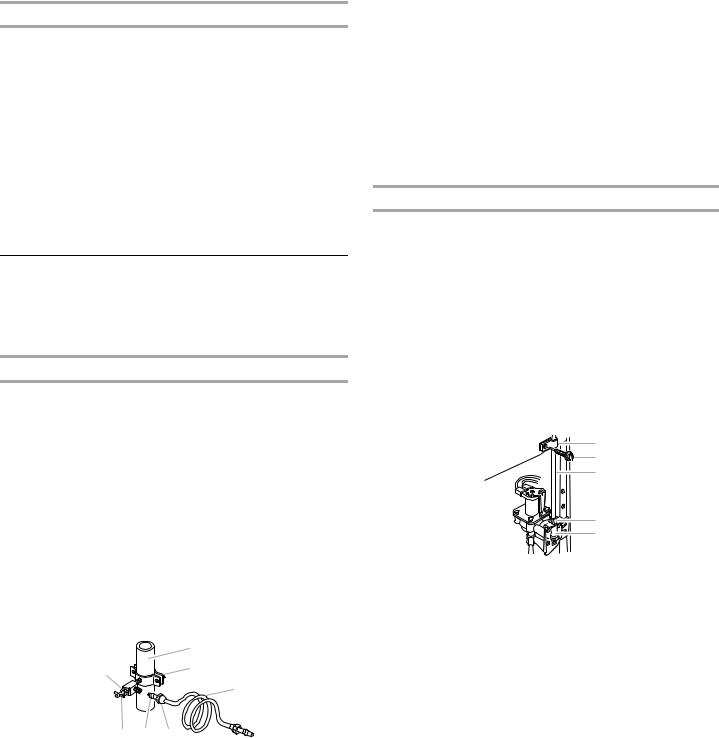
Water Pressure
A cold water supply with water pressure of between 30 and
120 psi (207 and 827 kPa) is required to operate the ice maker. If you have questions about your water pressure, call a licensed, qualified plumber.
Reverse Osmosis Water Supply
If a reverse osmosis water filtration system is connected to your cold water supply, the water pressure to the reverse osmosis system needs to be a minimum of 40 to 60 psi (276 to 414 kPa).
If the ice maker is still not operating properly:
■Check to see whether the sediment filter in the reverse osmosis system is blocked. Replace the filter if necessary.
■Allow the storage tank on the reverse osmosis system to refill after heavy usage.
If you have questions about your water pressure, call a licensed, qualified plumber.
ConnecttheWaterSupply
(onsomemodels)
Read all directions before you begin.
IMPORTANT: If you turn the refrigerator on before the water line is connected, turn the ice maker OFF.
Connect to Water Line
1.Unplug refrigerator or disconnect power.
2.Turn OFF main water supply. Turn ON nearest faucet long enough to clear line of water.
3.Locate a ¹⁄ " to 1¹⁄ " (1.27 cm to 3.18 cm) vertical cold water pipe near the refrigerator.
IMPORTANT:
■Make sure it is a cold water pipe.
■Horizontal pipe will work, but drill on the top side of the pipe, not the bottom. This will help keep water away from the drill and normal sediment from collecting in the valve.
4.Determine the length of copper tubing you will need. Measure from the connection on lower left rear of refrigerator to the water pipe. Add 7 ft (2.1 m) to allow for cleaning. Use ¹⁄ " (6.35 mm) O.D. (outside diameter) copper tubing. Be sure both ends of copper tubing are cut square.
5.Using a cordless drill, drill a ¹⁄ " hole in the cold water pipe you have selected.
|
A |
G |
B |
|
|
|
C |
F E |
D |
A. Cold water pipe |
E. Compression sleeve |
B. Pipe clamp |
F. Shutoff valve |
C. Copper tubing |
G. Packing nut |
D. Compression nut |
|
6.Fasten the shutoff valve to the cold water pipe with the pipe clamp. Be sure the outlet end is solidly in the ¹⁄ " drilled hole in the water pipe and that the washer is under the pipe clamp. Tighten the packing nut. Tighten the pipe clamp screws slowly and evenly so washer makes a watertight seal. Do not overtighten.
7.Slip the compression sleeve and compression nut on the copper tubing as shown. Insert the end of the tubing into the outlet end squarely as far as it will go. Screw compression nut onto outlet end with adjustable wrench. Do not overtighten.
8.Place the free end of the tubing in a container or sink, and turn ON the main water supply. Flush the tubing until water is clear. Turn OFF the shutoff valve on the water pipe. Coil the copper tubing.
Connect to Refrigerator
NOTE: On kit models, assemble water valve to refrigerator per kit instructions.
Style 1
1.Unplug refrigerator or disconnect power.
2.Attach the copper tube to the valve inlet using a compression nut and sleeve as shown. Tighten the compression nut. Do not overtighten.
3.Use the tube clamp on the back of the refrigerator to secure the tubing to the refrigerator as shown. This will help avoid damage to the tubing when the refrigerator is pushed back against the wall.
4.Turn shutoff valve ON.
5.Check for leaks. Tighten any connections (including connections at the valve) or nuts that leak.
A
B
C
D
E
A. Tube clamp |
D. Compression nut |
B. Tube clamp screw |
E. Valve inlet |
C.Copper tubing
6.The ice maker is equipped with a built-in water strainer. If your water conditions require a second water strainer, install it in the ¹⁄ " (6.35 mm) water line at either tube connection. Obtain a water strainer from your nearest appliance dealer.
Style 2
1.Unplug refrigerator or disconnect power.
2.Disconnect the tube clamp on the back of the product and insert the copper tubing through the clamp as shown.
3.Attach the copper tube to the valve inlet using a compression nut and sleeve as shown.
4
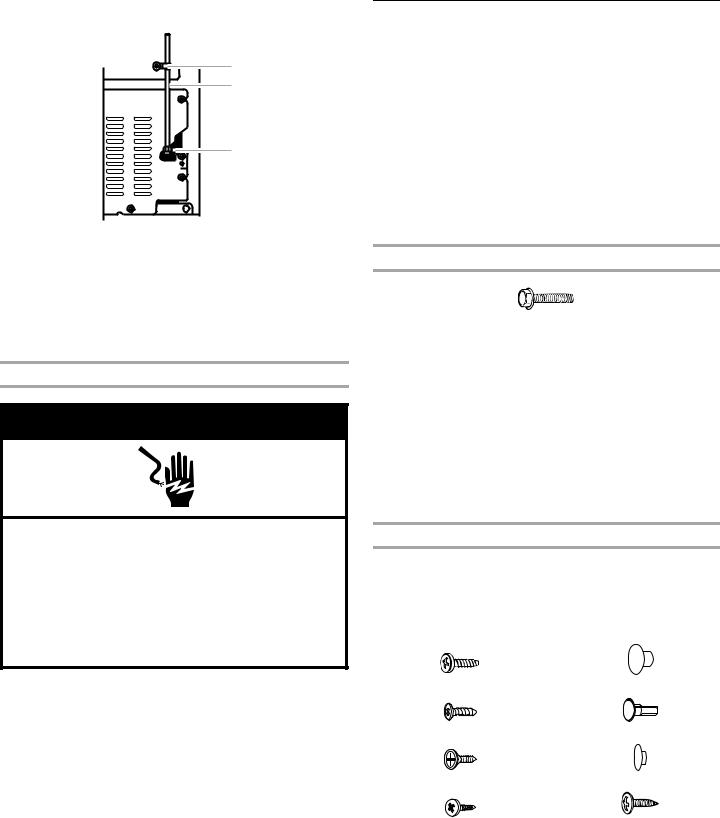
4.Tighten the compression nut. Do not overtighten. Reattach the tube clamp and tube to the back of the cabinet.
A
B
C
A. Tube clamp |
C. Compression nut |
B.Copper tubing
5.Turn shutoff valve ON. Check for leaks. Tighten any connections (including connections at the valve) or nuts that leak.
6.The ice maker is equipped with a built-in water strainer. If your water conditions require a second water strainer, install it in the ¹⁄" (6.35 mm) water line at either tube connection. Obtain a water strainer from your nearest appliance dealer.
Complete the Installation
 WARNING
WARNING
Electrical Shock Hazard
Plug into a grounded 3 prong outlet.
Do not remove ground prong.
Do not use an adapter.
Do not use an extension cord.
Failure to follow these instructions can result in death, fire, or electrical shock.
1. Plug into a grounded 3 prong outlet.
NOTE: Allow 24 hours to produce the first batch of ice. Discard the first three batches of ice produced. Allow 3 days to completely fill ice container.
RefrigeratorDoors
TOOLS NEEDED: ⁄" hex-head socket wrench, #2 Phillips screwdriver, flat-blade screwdriver, ⁄" open-end wrench, flat 2" putty knife.
IMPORTANT:
■Before you begin, turn the refrigerator control OFF. Unplug refrigerator or disconnect power.
■Remove food and adjustable door or utility bins from doors.
■If you are only removing and replacing the doors, see the “Remove Doors and Hinges” and “Replace Doors and Hinges” sections.
■Depending on your model, you may have standard (Style 1) or contoured (Style 2) doors. If you are also going to reverse the door swing, follow the instructions for the appropriate door style.
Remove Doors and Hinges
⁄" Hex-Head Hinge Screw
1.Unplug refrigerator or disconnect power.
2.Close the refrigerator door and keep both doors closed until you are ready to lift them free from the cabinet.
NOTE: Provide additional support for the doors while the hinges are being moved. Do not depend on the door magnets to hold the doors in place while you are working.
3.Remove the parts for the top hinge as shown in Top Hinge graphic. Lift the freezer door free from the cabinet.
4.Remove the parts for the center hinge as shown in the Center Hinge graphic. Lift the refrigerator door free from the cabinet.
5.Remove the parts for the bottom hinge as shown in the Bottom Hinge graphic.
Reverse Doors (optional)
IMPORTANT: If you want to reverse your doors so that they open in the opposite direction, follow these steps. If you are not reversing the doors, see “Replace Doors and Hinges.”
Style 1 - Standard
Graphics follow these instructions.
Door Stop Screw |
Door Hinge Hole Plug |
Door Handle Sealing Screw |
Cabinet Hinge Hole Plug |
Flat-Head Handle Screw |
Door Handle Screw Cover |
Door Handle Seal Screw Front |
Round-Head Handle Screw |
Cabinet
1.Remove ⁄" hex-head hinge screws from handle side and move them to opposite side. See Graphic 1-1.
2.Remove cabinet hinge hole plugs from cabinet top and move them to opposite side hinge holes as shown. See Graphic 1-2.
5
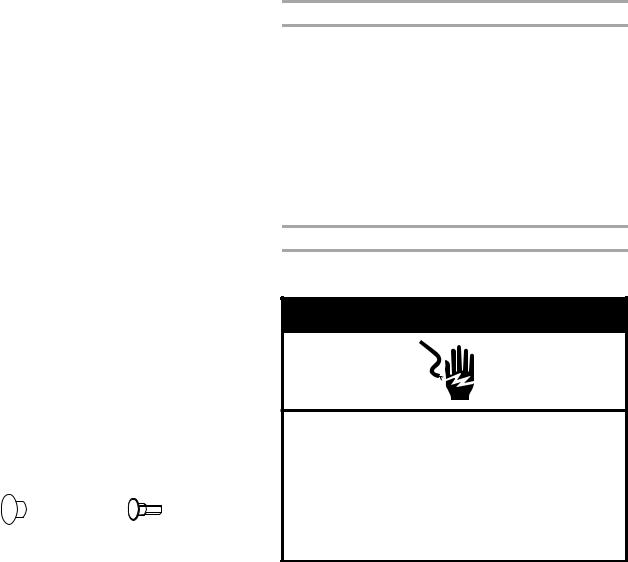
Freezer door
1.Remove freezer handle assembly as shown. Keep all parts together. See Graphic 2.
2.Remove door hinge hole plug. Move to opposite side as shown. See Graphic 3.
3.Remove door handle sealing screws. Move to opposite side of freezer door as shown. See Graphic 4.
4.Remove door stop. Move to opposite side of freezer door as shown. See Graphic 5.
5.Position freezer handle on opposite side of freezer door. Assemble handle on door as shown. See Graphic 2.
6.Tighten all screws. Set aside door until hinges and refrigerator compartment door are in place.
Refrigerator door
1.Remove the screw cover. See Graphic 6.
2.Remove refrigerator handle assembly as shown. Keep all parts together. See Graphic 6.
3.Remove door hinge hole plug from refrigerator door. Move to opposite side hinge hole as shown. See Graphic 3.
4.Remove door handle sealing screws. Move to opposite side of refrigerator door as shown. See Graphic 4.
5.Remove door handle seal screw front. Move to opposite side of refrigerator door as shown. See Graphic 7.
6.Remove door stop. Move to opposite side of refrigerator door as shown. See Graphic 5.
7.Position refrigerator handle on opposite side of the refrigerator door as shown. See Graphic 6. Drive top two screws in handle first. Align lower portion of handle and drive bottom screw.
8.Replace screw cover. See Graphic 6.
9.Tighten all screws. Set aside refrigerator door until bottom hinge is installed on refrigerator.
Style 2 - Contoured
Graphics follow these instructions.
Door Hinge |
Cabinet Hinge |
Hole Plug |
Hole Plug |
Cabinet
1.Remove ⁄" hex-head hinge screws from handle side and move them to opposite side. See Graphic 1-1.
2.Remove cabinet hinge hole plugs from the cabinet top and move them to opposite side hinge holes as shown. See Graphic 1-2.
Doors
1.Remove door hinge hole plug from top of freezer door. Move to opposite side as shown. See Graphic 2.
2.Remove door stop from both the freezer and refrigerator doors and move to the other side. See Graphic 3.
Replace Doors and Hinges
NOTE: Graphic may be reversed if door swing is reversed.
1.Replace the parts for the bottom hinge as shown. Tighten screws. Replace the refrigerator door.
NOTE: Provide additional support for the doors while the hinges are being moved. Do not depend on the door magnets to hold the doors in place while you are working.
2.Assemble the parts for the center hinge as shown and tighten all screws. See Center Hinge graphic. Replace the freezer door.
3.Assemble the parts for the top hinge as shown. See Top Hinge graphic. Do not tighten screws completely.
4.Line up the doors so that the bottom of the freezer door aligns evenly with the top of the refrigerator door. Tighten all screws.
Final Steps
1.Check all holes to make sure that hole plugs and screws are in place. Reinstall top hinge cover. See Top Hinge graphic.
 WARNING
WARNING
Electrical Shock Hazard
Plug into a grounded 3 prong outlet.
Do not remove ground prong.
Do not use an adapter.
Do not use an extension cord.
Failure to follow these instructions can result in death, fire, or electrical shock.
2.Plug into a grounded 3 prong outlet.
3.Reset the controls. See “Using the Control(s).”
4.Return all removable door parts to doors and food to refrigerator.
6
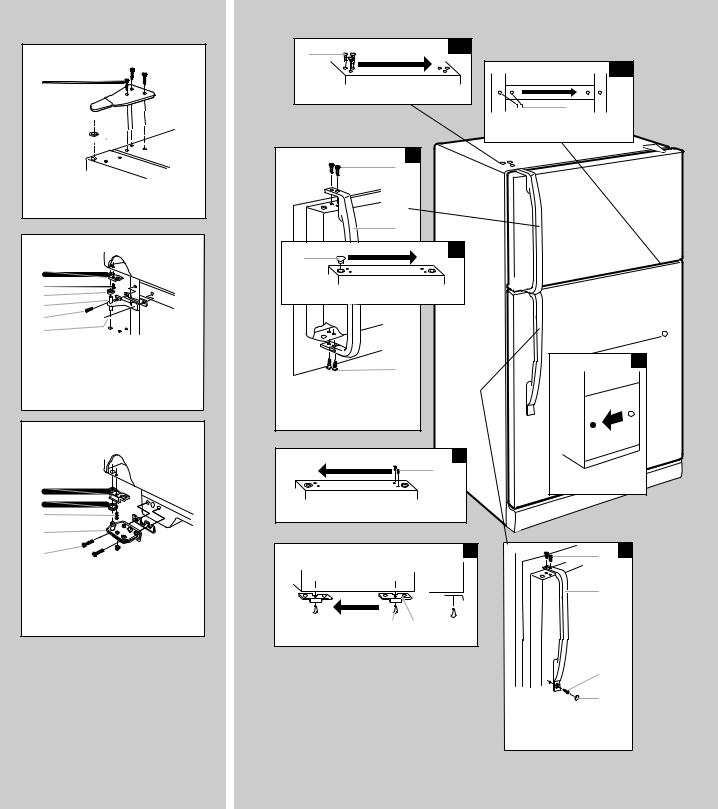
Style 1 - Standard
Door Removal &
Replacement
Top Hinge
A
B 

C 

A. 5/16" Hex-Head Hinge Screws
B.Top Hinge
C.Spacer
Center Hinge
A
B
C
D
E

F
A.Door Stop
B.Door Stop Screw
C.Spacer
D.Center Hinge
E.5/16" Hex-Head Hinge Screws
F.Spacer
Bottom Hinge |
A |
B |
C |
D |
E |
A. Door Stop |
B. Spacer |
C. Door Stop Screw |
D. Bottom Hinge |
E. 5/16" Hex-Head Hinge Screws |
Door Swing Reversal (optional)
1-2 |
A |
A. Cabinet Hinge Hole Plugs |
2 |
A |
B |
3 |
A |
A. Door Hinge Hole Plug |
A |
A. Flat-Head Handle Screws |
B. Freezer Handle |
4 |
A |
A. Door Handle Sealing Screws
Front View |
|
Side View |
5 |
A. Door Stop Screw |
A |
B |
|
B. Door Stop |
|
|
|
1-1
A
A. 5/16" Hex-Head Hinge
Screws and Washers
7 |
A. Door Handle |
Seal Screw Front |
6
A
B
C
D
A.Flat-Head Handle Screw
B.Refrigerator Handle
C.Handle Screw
D.Screw Cover
7
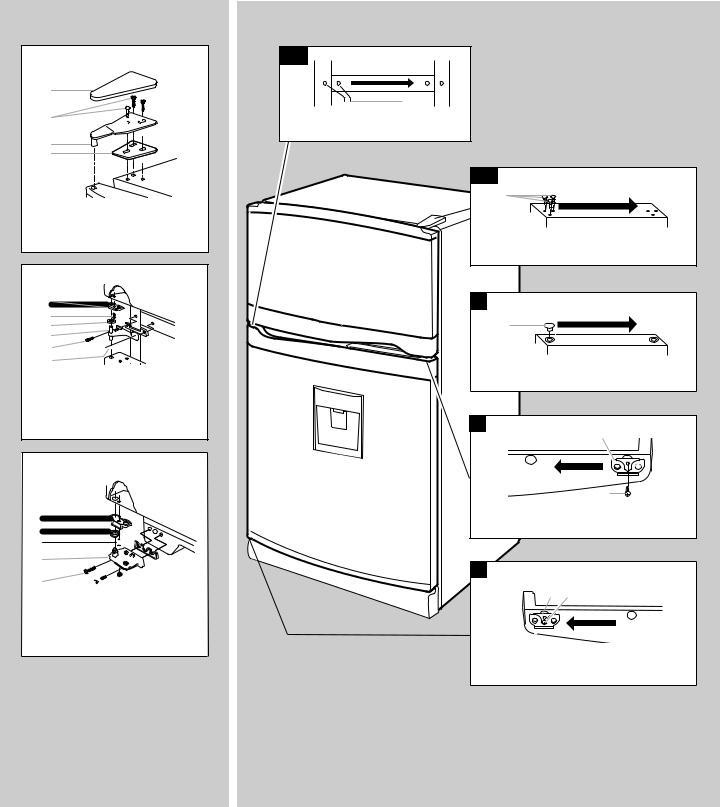
Style 2 - Contoured
Door Removal &
Replacement
Top Hinge
A
B 

C
D
A.Top Hinge Cover
B.5/16" Hex-Head Hinge Screws
C.Top Hinge
D.Spacer
Center Hinge
A
B
C
D
E

F
A.Door Stop
B.Door Stop Screw
C.Spacer
D.Center Hinge
E.5/16" Hex-Head Hinge Screws
F.Spacer
Bottom Hinge
A 

B 
C 

D
E



A.Door Stop
B.Spacer
C. Door Stop Screw D. Bottom Hinge
E. 5/16" Hex-Head Hinge Screws
Door Swing Reversal (optional)
1-1
A
A. 5/16" Hex-Head Hinge
Screws and Washers
1-2
A
A. Cabinet Hinge Hole Plugs
2
A
A. Door Hinge Hole Plug
3 |
Removal of Door Stops |
|
|
|
A |
|
B |
|
A. Door Stop |
|
B. Door Stop Screw |
4 Reinstallation of Door Stops |
|
|
A B |
A. Door Stop
B. Door Stop Screw
8
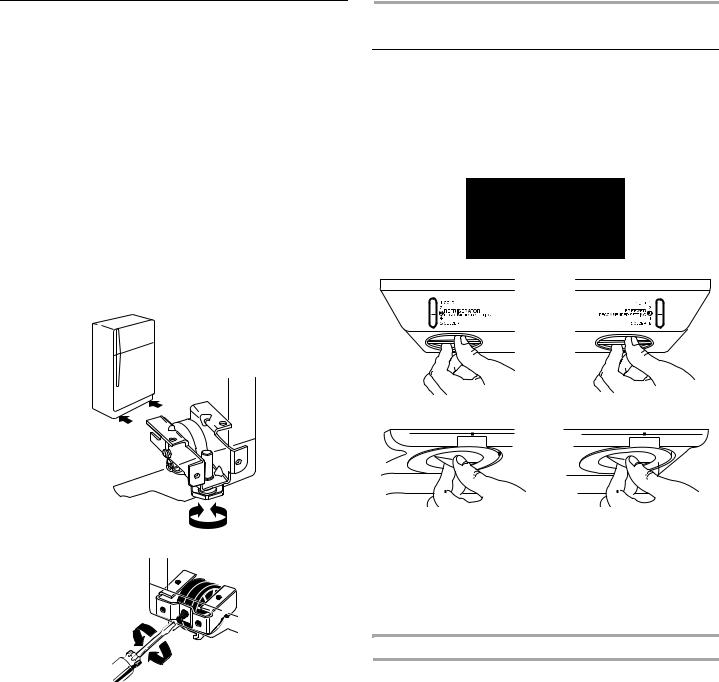
AdjusttheDoors
Your refrigerator has two front adjustable rollers – one on the right and one on the left. If your refrigerator seems unsteady or you want the doors to close easier, adjust the refrigerator's tilt using the instructions below.
Depending on your model, your refrigerator may have leveling legs (Style 1) or leveling screws (Style 2). They are part of the front roller assemblies which are found at the base of the refrigerator on either side.
1.Turn the leveling legs or leveling screws to the right to raise that side of the refrigerator or to the left to lower that side. It may take several turns to adjust the tilt of the refrigerator.
NOTE: Having someone push against the top of the refrigerator takes some weight off the leveling screws and rollers. This makes it easier to adjust the screws.
2.Open both doors again and be sure that they close as easily as you like. If not, tilt the refrigerator slightly more to the rear by turning both leveling screws to the right. It may take several more turns, and you should turn both leveling screws the same amount.
Style 1
REFRIGERATOR USE
UsingtheControls
For your convenience, your refrigerator controls are preset at the factory. When you first install your refrigerator, make sure that the controls are still preset to the mid-settings as shown.
NOTE: To turn your refrigerator off, turn the refrigerator control to the word OFF or until the word OFF appears. Your product will not cool when the refrigerator control is set to OFF.
Mid-setting “3”
1
 3 normal
3 normal
off |
5 coldest |
Mid-setting “3”
Mid-setting “4”
REFRIGERATOR |
4 |
4 |
FREEZER |
|
|
Style 2
3.Using a level, be sure that the refrigerator is still level side to side. Readjust if necessary.
IMPORTANT:
■Give your refrigerator time to cool down completely before adding food. It is best to wait 24 hours before you put food into the refrigerator.
■If you add food before the refrigerator has cooled completely, your food may spoil. Adjusting the Refrigerator and Freezer Controls to a higher (colder) than recommended setting will not cool the compartments any faster.
Adjusting Controls
The mid-settings indicated in the previous section should be correct for normal household usage. The controls are set correctly when milk or juice is as cold as you like and when ice cream is firm.
If the temperature is too warm or too cold in the refrigerator or freezer, first check the air vents to be sure they are not blocked.
If you need to adjust temperatures, use the settings listed in the chart below as a guide. On models with two controls, adjust the refrigerator temperature first. Wait at least 24 hours between adjustments and then recheck the temperatures.
9

CONDITION/REASON: |
ADJUSTMENT: |
|
|
|
|
REFRIGERATOR section too warm |
Adjust REFRIGERATOR |
|
- Door opened often, large amount |
or TEMPERATURE |
|
Control one setting |
||
of food added or room |
||
higher |
||
temperature very warm |
||
|
||
|
|
|
FREEZER section too warm/ice not |
Adjust FREEZER or |
|
made fast enough |
TEMPERATURE Control |
|
- Door opened often, or large |
one setting higher |
|
amount of food added or very cold |
|
|
room temperature (can’t cycle |
|
|
often enough) |
|
|
- Heavy ice usage |
|
|
|
|
|
REFRIGERATOR section too cold |
Adjust REFRIGERATOR |
|
- Controls not set correctly for your |
or TEMPERATURE |
|
Control one setting |
||
conditions |
||
lower |
||
|
||
|
|
|
FREEZER section too cold |
Adjust FREEZER or |
|
- Controls not set correctly for your |
TEMPERATURE Control |
|
one setting lower |
||
conditions |
||
|
IceMaker
(onsomemodels-Accessory)
Turning the Ice Maker On/Off
NOTE: Do not force the wire shutoff arm up or down.
■To turn the ice maker on, simply lower the wire shutoff arm.
NOTE: Your ice maker has an automatic shutoff. As ice is made, the ice cubes will fill the ice storage bin and the ice cubes will raise the wire shutoff arm to the OFF (arm up) position.
■To manually turn the ice maker off, lift the wire shutoff arm to the OFF (arm up) position and listen for the click to make sure the ice maker will not continue to operate.
MAX
NORMAL
Ice Production Rate
■NORMAL Ice Production: The ice maker should produce approximately 8 to 12 batches of ice in a 24-hour period. If ice is not being made fast enough, turn the Freezer Control toward a higher (colder) number in half number steps. (For example, if the control is at 3, move it to between 3 and 4.) Wait 24 hours and, if necessary, gradually turn the Freezer Control to the highest setting, waiting 24 hours between each increase.
■MAXIMUM Ice Production (on some models): The ice maker should produce approximately 16 to 20 batches of ice in a 24hour period. If your refrigerator has the maximum ice production feature, push the switch to MAX.
Remember
■Allow 24 hours to produce the first batch of ice. Discard the first three batches of ice produced.
■The quality of your ice will be only as good as the quality of the water supplied to your ice maker. Avoid connecting the ice maker to a softened water supply. Water softener chemicals (such as salt) can damage parts of the ice maker and lead to poor quality ice. If a softened water supply cannot be avoided, make sure the water softener is operating properly and is well maintained.
■Do not store anything on top of the ice maker or in the ice storage bin.
QuickTap™BeverageDispenser
(onsomemodels)
Your refrigerator may have an exterior beverage dispenser. This innovative feature allows easy access to chilled beverages without opening your refrigerator door, which may help reduce energy consumption.
IMPORTANT:
■The Quick Tap™ beverage dispenser is to be used only for water or clear, liquid beverages. Using beverages such as milk or juices with pulp or seeds may clog the valve and cause the dispenser to malfunction.
■Clean the beverage dispensing system before using it for the first time. Fill the storage tank with clean water and press the dispensing lever with a large container to dispense at least
1 liter of water. Discard the water. This cleans the system and clears air from the dispenser valve.
■For your convenience, we have provided an extra dispenser valve. It is recommended that you replace the beverage dispenser valve approximately every 6 months.
Contact Amana to purchase a replacement beverage dispenser valve, Part Number 2328499. In the U.S.A., call
1-877-232-6771 or visit www.amana.com. In Canada, call 1-800-807-6777 or visit www.amanacanada.ca.
■When turning on the refrigerator for the first time, allow 24 hours for the refrigerator to cool down and chill the beverage.
NOTE: Keeping the beverage cold does not mean the drink will last longer.
■Dispense enough beverage during the week to keep the beverage fresh. The beverage may acquire a strange taste if the dispenser is not used regularly. Do not store a beverage in the dispenser for longer than 1 week.
NOTES:
■Carbonated beverages may lose their fizz after a 6-hour period.
■Clean the storage tank and dispenser parts before refilling with a new beverage. See “Clean the Beverage Storage Tank.”
IMPORTANT: The manufacturer is not liable for damages caused to the dispenser and its system, should liquids other than water or clear beverages be used.
10
